A Novel ENSO Monitoring Method using Precipitable Water Vapor and Temperature in Southeast China
Abstract
1. Introduction
2. Materials and Methods
2.1. Materials Description
2.2. Empirical Orthogonal Function
2.3. MWCA
2.4. MSSA
2.5. Retrieval of PWV Based on the GNSS Observation
3. Analysis of Anomalous Variations of PWV and T During ENSO
3.1. Spatiotemporal Characteristic Analysis of PWV and SST/T
3.2. Determination of Response Thresholds of PWV and T to ENSO in Southeast China
3.3. Anomalous Analysis of PWV and T during ENSO Period using MSSA
3.4. Standard PWV and Temperature Index (SPTI)
- (1)
- The time series of PWV and T is reprocessed by removing the trend and periodic terms using the MSSA;
- (2)
- The reprocessed PWV and T time series are normalized due to their different magnitudes using the following formula [60]:where and are the maximum and minimum values of the mapping range, which usually are 1 and −1, respectively. and are the maximum and minimum values of the N vector, respectively. and are the value in the N vector and the normalized value corresponding to the value in the N vector, respectively;
- (3)
- The optimal weightings of the normalized PWV and T time series are determined using the MSSA method. The anomalous variations (RC6 in Figure 6) of PWV and T obtained using the MSSA are correlated with ENSO. Therefore, the reprocessed PWV and T time series are used to obtain the variance contribution rates of abnormal signals. Then, these rates are used to determine the optimal weightings between PWV and T. The weighted normalized value for calculating the SPTI can be obtained and expressed as:where and are the normalized PWV and T values, respectively. and are the weightings of PWV and T, respectively. is the normalized PWV and T value, which is used to calculate the SPTI based on the Z score method [61]. The Z score is the deviation from the mean in units of the standard deviation. The SPTI time series is calculated using the monthly value over the period of 1979–2017 as follows:where refers to the monthly SPTI value during month for year . is the mean NPT during month over years. is the standard deviation of NPT during month over years, which is used to reflect the degree of deviation of PWV and T from normal value.
4. Validation of the SPTI for Monitoring ENSO
4.1. Validation of the SPTI using the ECMWF Data
4.2. Validation of SPTI At GNSS/RS Stations
5. Conclusions
Author Contributions
Funding
Acknowledgment
Conflicts of Interest
References
- Chung, E.-S.; Soden, B.; Sohn, B.J.; Shi, L. Upper-tropospheric moistening in response to anthropogenic warming. Proc. Natl. Acad. Sci. USA 2014, 111, 11636–11641. [Google Scholar] [CrossRef]
- Guerova, G.; Jones, J.; Douša, J.; Dick, G.; De Haan, S.; Pottiaux, E.; Bock, O.; Pacione, R.; Elgered, G.; Vedel, H.; et al. Review of the state of the art and future prospects of the ground-based GNSS meteorology in Europe. Atmospheric Meas. Tech. 2016, 9, 5385–5406. [Google Scholar] [CrossRef]
- Wang, X.; Zhang, K.; Wu, S.; Li, Z.; Cheng, Y.; Li, L.; Yuan, H. The correlation between GNSS-derived precipitable water vapor and sea surface temperature and its responses to El Niño–Southern Oscillation. Remote. Sens. Environ. 2018, 216, 1–12. [Google Scholar] [CrossRef]
- Trenberth, K.E.; Dai, A.; Rasmussen, R.M.; Parsons, D.B. The Changing Character of Precipitation. Bull. Am. Meteorol. Soc. 2003, 84, 1205–1218. [Google Scholar] [CrossRef]
- O’Gorman, P.A.; Muller, C.J. How closely do changes in surface and column water vapor follow Clausius–Clapeyron scaling in climate change simulations? Environ. Res. Lett. 2010, 5, 025207. [Google Scholar] [CrossRef]
- Xie, B.; Zhang, Q.; Ying, Y. Trends in Precipitable Water and Relative Humidity in China: 1979–2005. J. Appl. Meteorol. Clim. 2011, 50, 1985–1994. [Google Scholar] [CrossRef]
- Guerova, G. Derivation of Integrated Water Vapor (IWV) from the ground-based GPS estimates of Zenith Total Delay (ZTD); Department of Microwave Physics, Institute of Applied Physics, University of Bern: Bern, Switzerland, 2003. [Google Scholar]
- Bengtsson, L.; Hagemann, S.; Hodges, K.I. Can climate trends be calculated from reanalysis data? J. Geophys. Res. 2004, 109, D11111. [Google Scholar] [CrossRef]
- Dessler, A.E.; Davis, S.M. Trends in tropospheric humidity from reanalysis systems. J. Geophys. Res. 2010, 115, D19127. [Google Scholar] [CrossRef]
- Zhang, B.; Liu, L.; Khan, S.A.; Van Dam, T.; Zhang, E.; Yao, Y. Transient Variations in Glacial Mass Near Upernavik Isstrøm (West Greenland) Detected by the Combined Use of GPS and GRACE Data. J. Geophys. Res. Solid Earth 2017, 122, 10–626. [Google Scholar] [CrossRef]
- Bevis, M.; Businger, S.; Herring, T.A.; Rocken, C.; Anthes, R.A.; Ware, R.H. GPS meteorology: Remote sensing of atmospheric water vapor using the global positioning system. J. Geophys. Res. Atmos. 1992, 97, 15787. [Google Scholar] [CrossRef]
- Nilsson, T.; Gradinarsky, L. Water vapor tomography using GPS phase observations: Simulation results. IEEE Trans. Geosci. Remote. Sens. 2006, 44, 2927–2941. [Google Scholar] [CrossRef]
- Jin, S.; Park, J.-U.; Cho, J.-H.; Park, P.-H. Seasonal variability of GPS-derived zenith tropospheric delay (1994–2006) and climate implications. J. Geophys. Res. 2007, 112, D09110. [Google Scholar] [CrossRef]
- McPhaden, M.J. El Nino and La Nina: Causes and global consequences. Encycl. Glob. Environ. Chang. 2002, 1, 1–17. [Google Scholar]
- Trenberth, K.E.; Hoar, T.J. El Niño and climate change. Geophys. Res. Lett. 1997, 24, 3057–3060. [Google Scholar] [CrossRef]
- Zhou, L.-T.; Tam, C.-Y.; Zhou, W.; Chan, J.C.L. Influence of South China Sea SST and the ENSO on winter rainfall over South China. Adv. Atmos. Sci. 2010, 27, 832–844. [Google Scholar] [CrossRef]
- Zhou, L.-T.; Wu, R. Respective impacts of the East Asian winter monsoon and ENSO on winter rainfall in China. J. Geophys. Res. 2010, 115, D02107. [Google Scholar] [CrossRef]
- Karori, M.A.; Li, J.; Jin, F.-F. The Asymmetric Influence of the Two Types of El Niño and La Niña on Summer Rainfall over Southeast China. J. Clim. 2013, 26, 4567–4582. [Google Scholar] [CrossRef]
- Zhang, L.; Fraedrich, K.; Zhu, X.; Frank, S.; Zhi, X. Interannual variability of winter precipitation in Southeast China. Theor. Appl. Climatol. 2015, 119, 229–238. [Google Scholar] [CrossRef]
- Li, X.; Zhou, W.; Chen, Y.D. Assessment of Regional Drought Trend and Risk over China: A Drought Climate Division Perspective. J. Clim. 2015, 28, 7025–7037. [Google Scholar] [CrossRef]
- Huang, R.; Chen, J.; Huang, G. Characteristics and variations of the East Asian monsoon system and its impacts on climate disasters in China. Adv. Atmospheric Sci. 2007, 24, 993–1023. [Google Scholar] [CrossRef]
- Sun, C.; Yang, S. Persistent severe drought in southern China during winter-spring 2011: Large-scale circulation patterns and possible impacting factors. J. Geophys. Res. 2012, 117, D10112. [Google Scholar] [CrossRef]
- Huang, R.; Wu, Y. The influence of ENSO on the summer climate change in China and its mechanism. Adv. Atmos. Sci. 1989, 6, 21–32. [Google Scholar]
- Zhang, R.; Sumi, A. Moisture circulation over East Asia during the El Niño episode in northern winter, spring, and autumn. J. Meteorol. Soc. Jpn. 2002, 80, 213–227. [Google Scholar] [CrossRef]
- Chowdhury, M.R. The El Niño-Southern Oscillation (ENSO) and seasonal flooding-Bangladesh. Theor. Appl. Climatol. 2003, 76, 105–124. [Google Scholar] [CrossRef]
- Tong, J.; Zhang, Q.; Zhu, D.M.; Wu, Y.J. Yangtze floods and droughts (China) and teleconnections with ENSO activities (1470–2003). Quat. Int. 2006, 144, 29–37. [Google Scholar] [CrossRef]
- AlShawaf, F.; Balidakis, K.; Dick, G.; Heise, S.; Wickert, J. Estimating trends in atmospheric water vapor and temperature time series over Germany. Atmos. Meas. Tech. 2017, 10, 3117–3132. [Google Scholar] [CrossRef]
- Sun, D.Z.; Held, I.M. A comparison of modeled and observed relationships between interannual variations of water vapor and temperature. J. Clim. 1995, 9, 665–675. [Google Scholar] [CrossRef]
- Bordi, I.; Zhu, X.; Fraedrich, K. Precipitable water vapor and its relationship with the Standardized Precipitation Index: Ground-based GPS measurements and reanalysis data. Theor. Appl. Climatol. 2016, 123, 263–275. [Google Scholar] [CrossRef]
- Vicente-Serrano, S.M.; Beguería, S.; López-Moreno, J.I. A Multiscalar Drought Index Sensitive to Global Warming: The Standardized Precipitation Evapotranspiration Index. J. Clim. 2010, 23, 1696–1718. [Google Scholar] [CrossRef]
- Akinremi, O.O.; McGinn, S.M.; Barr, A.G. Evaluation of the Palmer Drought Index on the Canadian Prairies. J. Clim. 1996, 9, 897–905. [Google Scholar] [CrossRef]
- Weber, L.; Nkemdirim, L.C. The Palmer drought severity index revisited. Geogr. Ann. 1998, 80, 153–172. [Google Scholar] [CrossRef]
- Zhao, Q.; Yao, Y.; Yao, W.; Zhang, S. GNSS-derived PWV and comparison with radiosonde and ECMWF ERA-Interim data over mainland China. J. Atmos. Sol. Terr. Phys. 2019, 182, 85–92. [Google Scholar] [CrossRef]
- Smith, T.M.; Reynolds, R.W.; Peterson, T.C.; Lawrimore, J. Improvements to NOAA’s Historical Merged Land–Ocean Surface Temperature Analysis (1880–2006). J. Clim. 2008, 21, 2283–2296. [Google Scholar] [CrossRef]
- Camp, C.D.; Tung, K.-K. Stratospheric polar warming by ENSO in winter: A statistical study. Geophys. Res. Lett. 2007, 34, L04809. [Google Scholar] [CrossRef]
- Pearson, K. LIII. On lines and planes of closest fit to systems of points in space. Lond. Edinb. Dublin Philos. Mag. J. Sci. 1902, 2, 559–572. [Google Scholar] [CrossRef]
- Lorenz, E.N. Empirical Orthogonal Functions and Statistical Weather Prediction; Massachusetts Institute of Technology, Department of Meteorology: Cambridge, MA, USA, 1956. [Google Scholar]
- Weare, B.C.; Navato, A.R.; Newell, R.E. Empirical Orthogonal Analysis of Pacific Sea Surface Temperatures. J. Phys. Oceanogr. 1976, 6, 671–678. [Google Scholar] [CrossRef]
- Kidson, J.W. Eigenvector Analysis of Monthly Mean Surface Data. Mon. Weather. Rev. 1975, 103, 177–186. [Google Scholar] [CrossRef]
- Lagerloef, G.S.E.; Bernstein, R.L. Empirical orthogonal function analysis of advanced very high resolution radiometer surface temperature patterns in Santa Barbara Channel. J. Geophys. Res. Oceans 1988, 93, 6863. [Google Scholar] [CrossRef]
- Hannachi, A.; O’Neill, A. Atmospheric multiple equilibria and non-Gaussian behaviour in model simulations. Q. J. R. Meteorol. Soc. 2001, 127, 939–958. [Google Scholar] [CrossRef]
- Kim, S.E.; Seo, I.W.; Choi, S.Y. Assessment of water quality variation of a monitoring network using exploratory factor analysis and empirical orthogonal function. Environ. Model. Softw. 2017, 94, 21–35. [Google Scholar] [CrossRef]
- Hannachi, A.; Jolliffe, I.T.; Stephenson, D.B. Empirical orthogonal functions and related techniques in atmospheric science: A review. Int. J. Clim. 2007, 27, 1119–1152. [Google Scholar] [CrossRef]
- Propastin, P. Monitoring System for Assessment of Vegetation Sensitivity to El-Niño over Africa; Springer Science and Business Media LLC: Berlin, German, 2009; pp. 329–344. [Google Scholar]
- Zhao, Q.; Ma, X.; Yao, W.; Liu, Y.; Yao, Y. Anomaly variation of vegetation and its influencing factors in Mainland China during ENSO period. IEEE Access 2019, 8, 721–734. [Google Scholar] [CrossRef]
- Ghil, M.; Vautard, R. Interdecadal oscillations and the warming trend in global temperature time series. Nature 1991, 350, 324–327. [Google Scholar] [CrossRef]
- Vautard, R.; Yiou, P.; Ghil, M. Singular-spectrum analysis: A toolkit for short, noisy chaotic signals. Phys. D Nonlinear Phenom. 1992, 58, 95–126. [Google Scholar] [CrossRef]
- Semiromi, M.T.; Ghasemian, D. Reconstruction of Water Infiltration Rate Reducibility in Response to Suspended Solid Characteristics Using Singular Spectrum Analysis: An Application to the Caspian Sea Coast of Nur, Iran. Hydrology 2018, 5, 59. [Google Scholar] [CrossRef]
- Plaut, G.; Vautard, R. Spells of Low-Frequency Oscillations and Weather Regimes in the Northern Hemisphere. J. Atmos. Sci. 1994, 51, 210–236. [Google Scholar] [CrossRef]
- Huang, W.; Wang, R.; Yuan, Y.; Gan, S.; Chen, Y. Signal extraction using randomized-order multichannel singular spectrum analysis. Geophysics 2016, 82, V69–V84. [Google Scholar] [CrossRef]
- Ghil, M.; Allen, M.R.; Dettinger, M.D.; Ide, K.; Kondrashov, D.; Mann, M.E.; Robertson, A.W.; Saunders, A.; Tian, Y.; Varadi, F.; et al. Advanced spectral methods for climatic time series. Rev. Geophys. 2002, 40, 1–41. [Google Scholar] [CrossRef]
- Herring, T.A.; King, R.W.; McClusky, S.C. Documentation of the GAMIT GPS Analysis Software Release 10.4; Department of Earth and Planetary Sciences: Cambridge, MA, USA, 2010; pp. 1–171. [Google Scholar]
- Saastamoinen, J. Atmospheric correction for the troposphere and stratosphere in radio ranging satellites. Use Artif. Satell. Geod. 1972, 15, 247–251. [Google Scholar]
- Tregoning, P.; Herring, T.A. Impact of a priori zenith hydrostatic delay errors on GPS estimates of station heights and zenith total delays. Geophys. Res. Lett. 2006, 33, L23303. [Google Scholar] [CrossRef]
- Bevis, M.; Businger, S.; Chiswell, S.; Thomas, A.H.; Richard, A.A.; Christian, R.; Randolph, H.W. GPS meteorology: Mapping zenith wet delays onto precipitable water. J. Appl. Meteorol. 1994, 33, 379–386. [Google Scholar] [CrossRef]
- Zhao, Q.; Yao, Y.; Yao, W. GPS-based PWV for precipitation forecasting and its application to a typhoon event. J. Atmos. Sol. Terr. Phys. 2018, 167, 124–133. [Google Scholar] [CrossRef]
- Yao, Y.; Shan, L.; Zhao, Q. Establishing a method of short-term rainfall forecasting based on GNSS-derived PWV and its application. Sci. Rep. 2017, 7, 12465. [Google Scholar] [CrossRef] [PubMed]
- Zou, K.H.; Tuncali, K.; Silverman, S.G. Correlation and Simple Linear Regression. Radiology 2003, 227, 617–628. [Google Scholar] [CrossRef] [PubMed]
- Golyandina, N.; Zhigljavsky, A. Singular Spectrum Analysis for Time Series; Springer Science and Business Media LLC: Berlin, Germany, 2013. [Google Scholar]
- Stolcke, A.; Kajarekar, S.; Ferrer, L. Nonparametric feature normalization for SVM-based speaker verification. In Proceedings of the 2008 IEEE International Conference on Acoustics, Speech and Signal Processing; Institute of Electrical and Electronics Engineers (IEEE), Las Vegas, NV, USA, 30 March–4 April 2008; pp. 1577–1580. [Google Scholar]
- Peters, A.J.; Walter-Shea, E.A.; Ji, L.; Andres, V.; Michael, H.; Mark, D.S. Drought monitoring with NDVI-based standardized vegetation index. Photogramm. Eng. Remote. Sens. 2002, 68, 71–75. [Google Scholar]
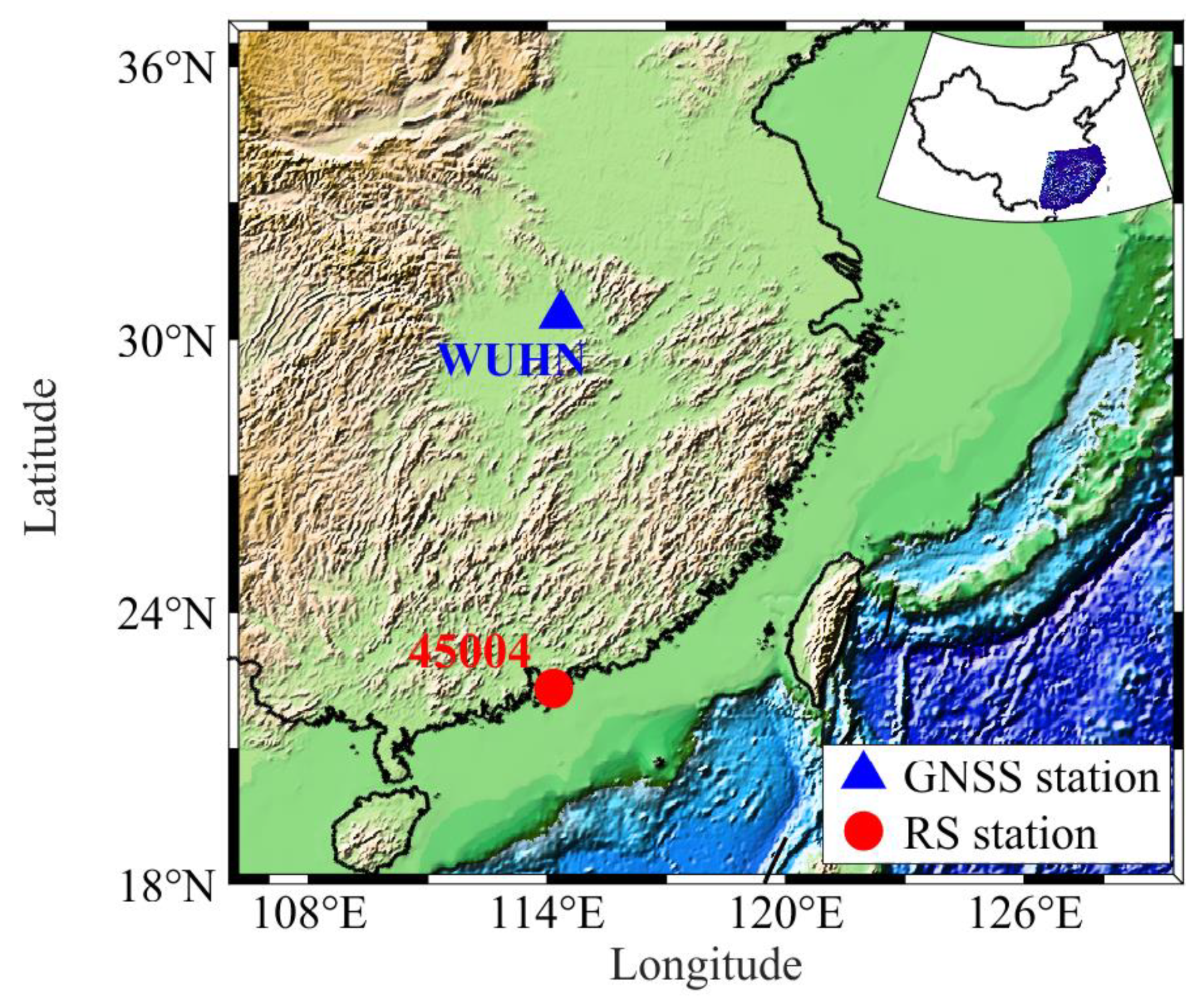
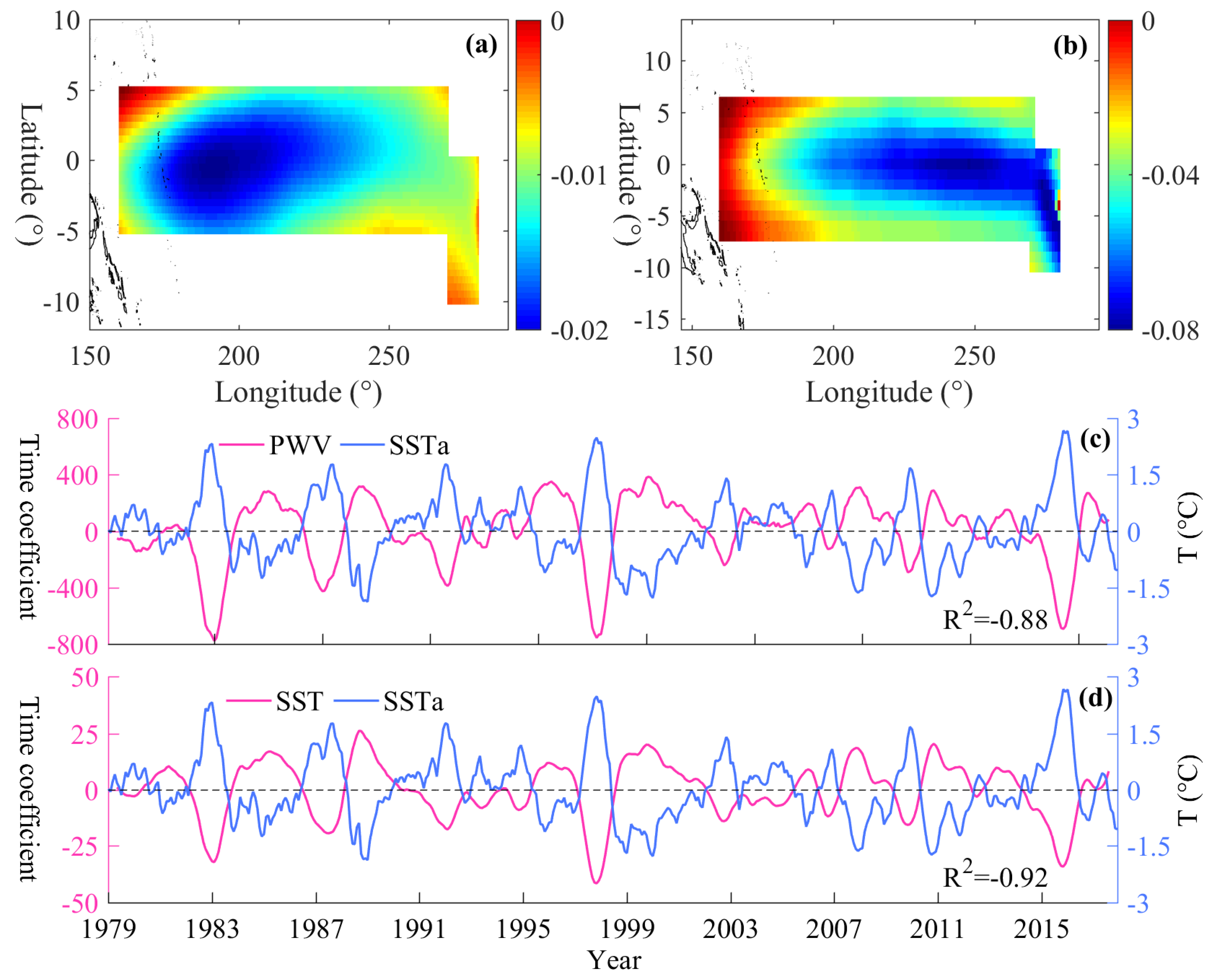
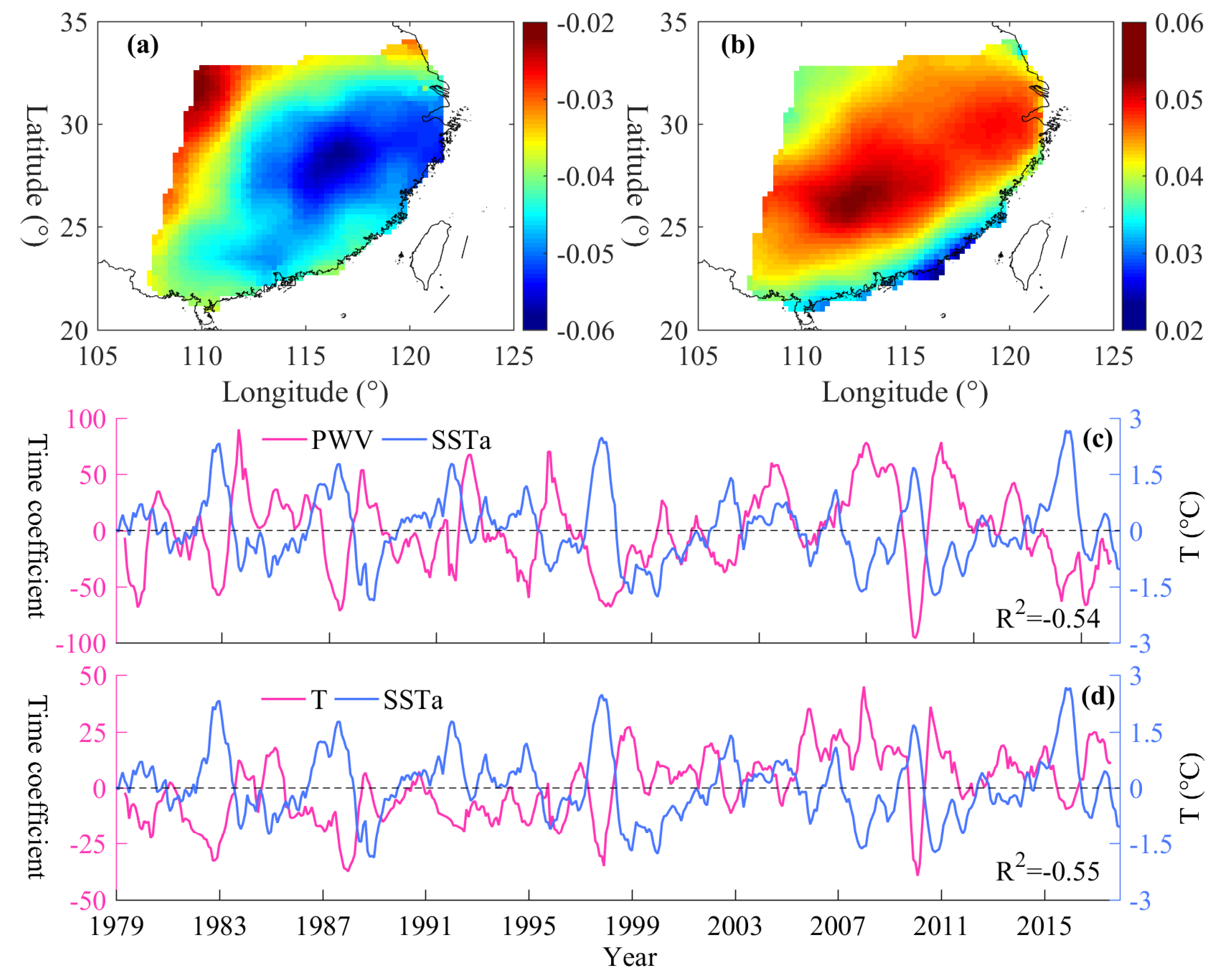
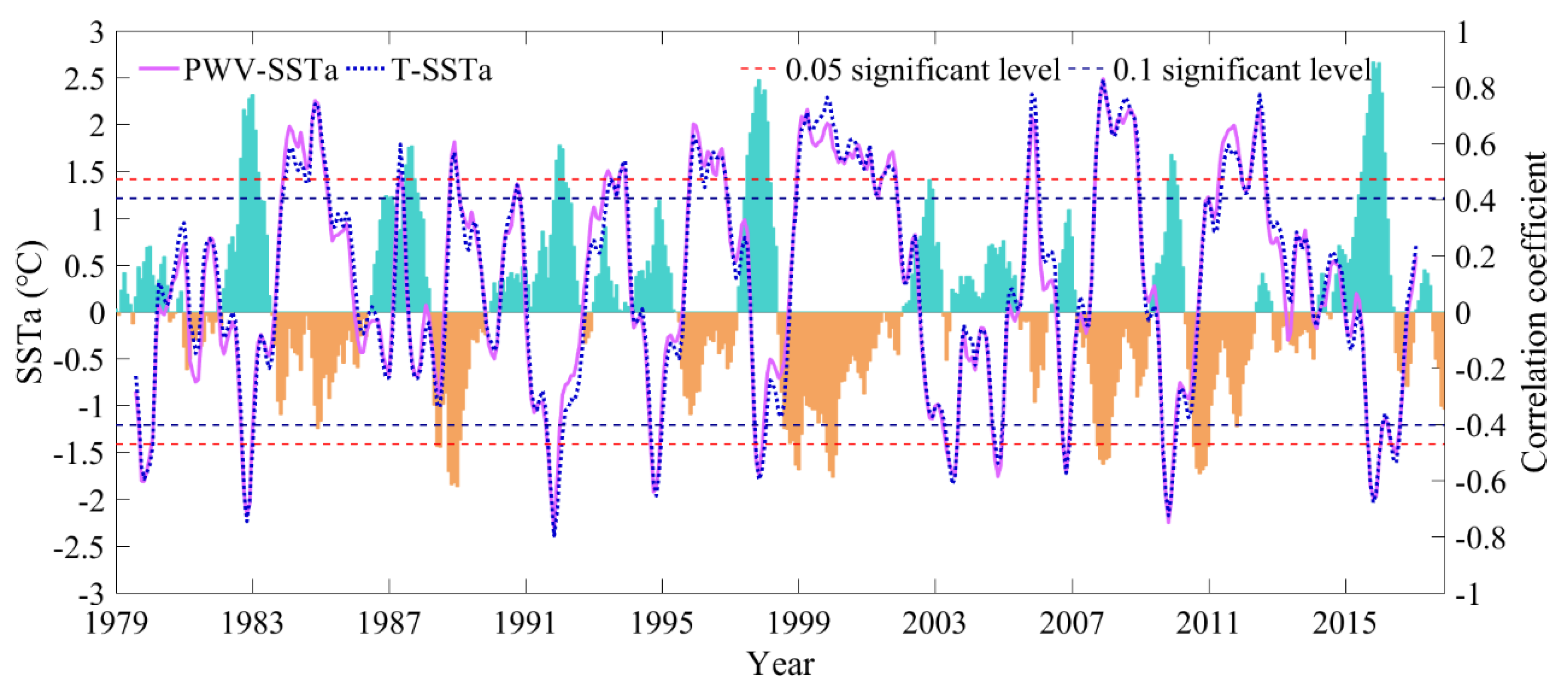

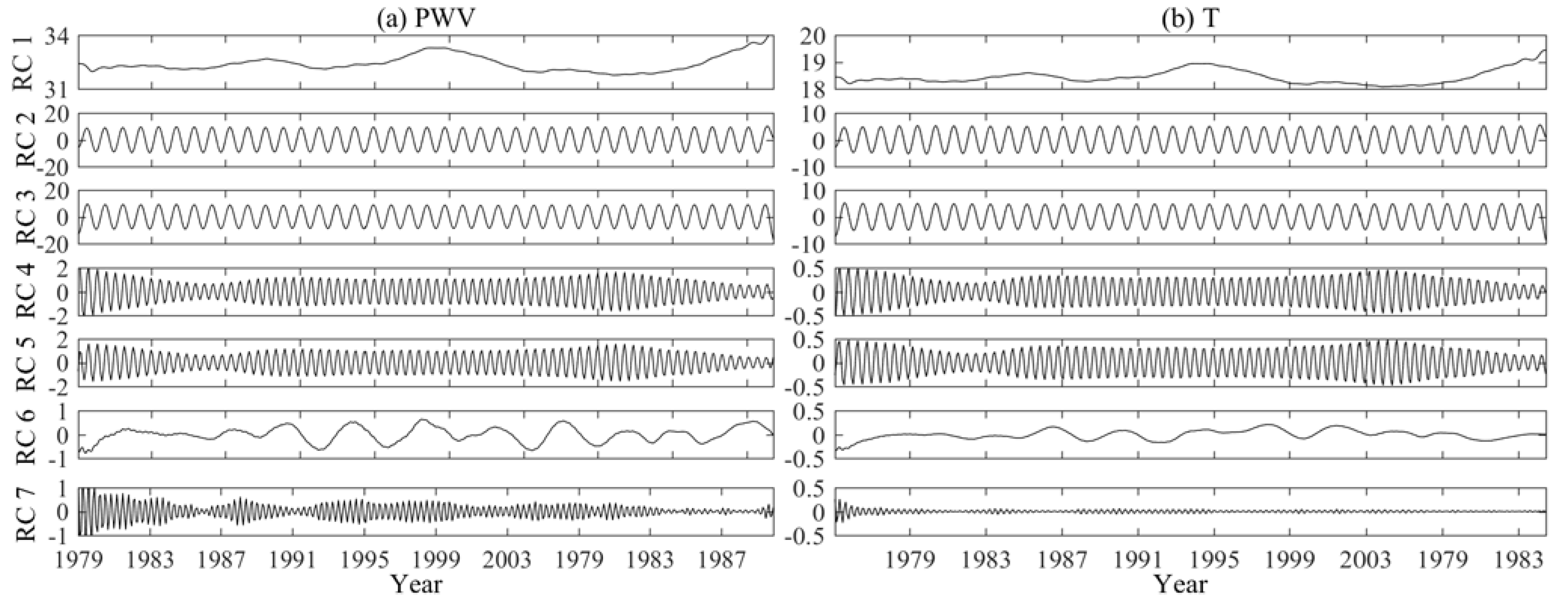
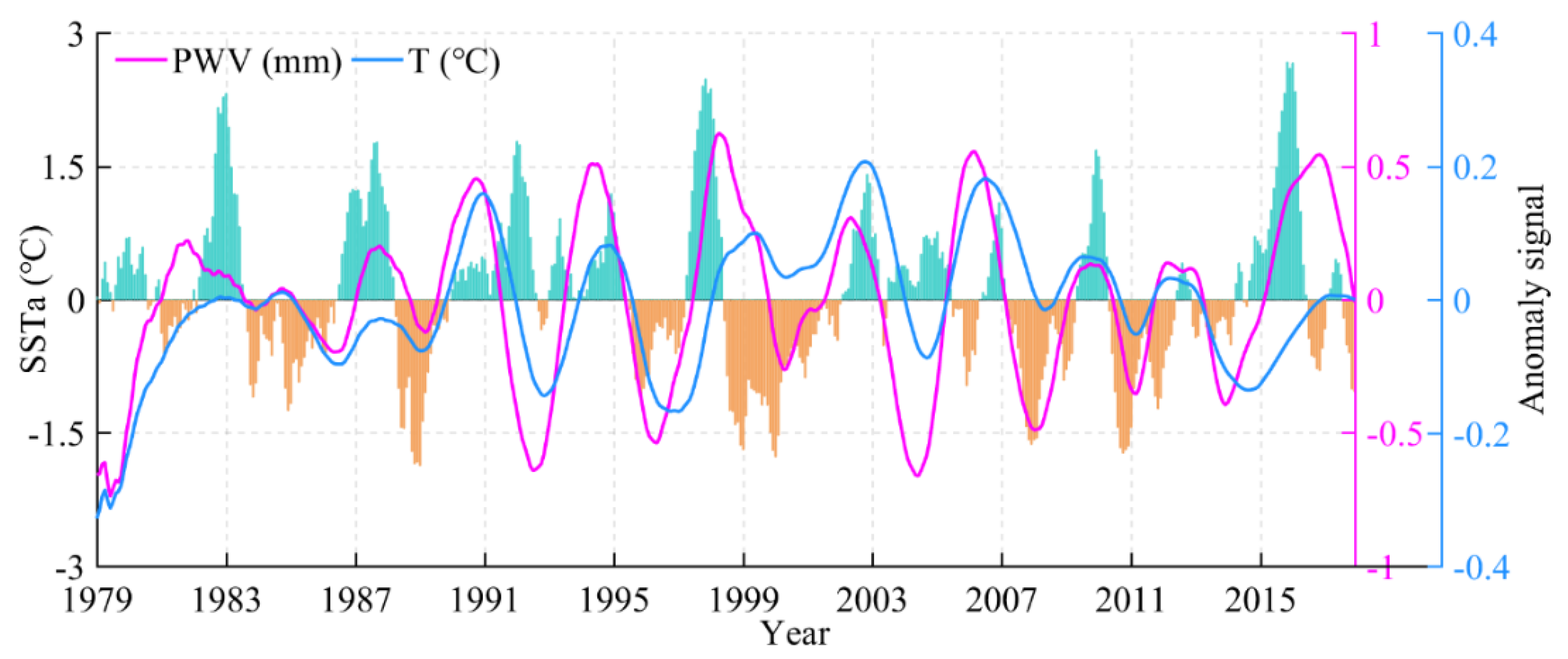
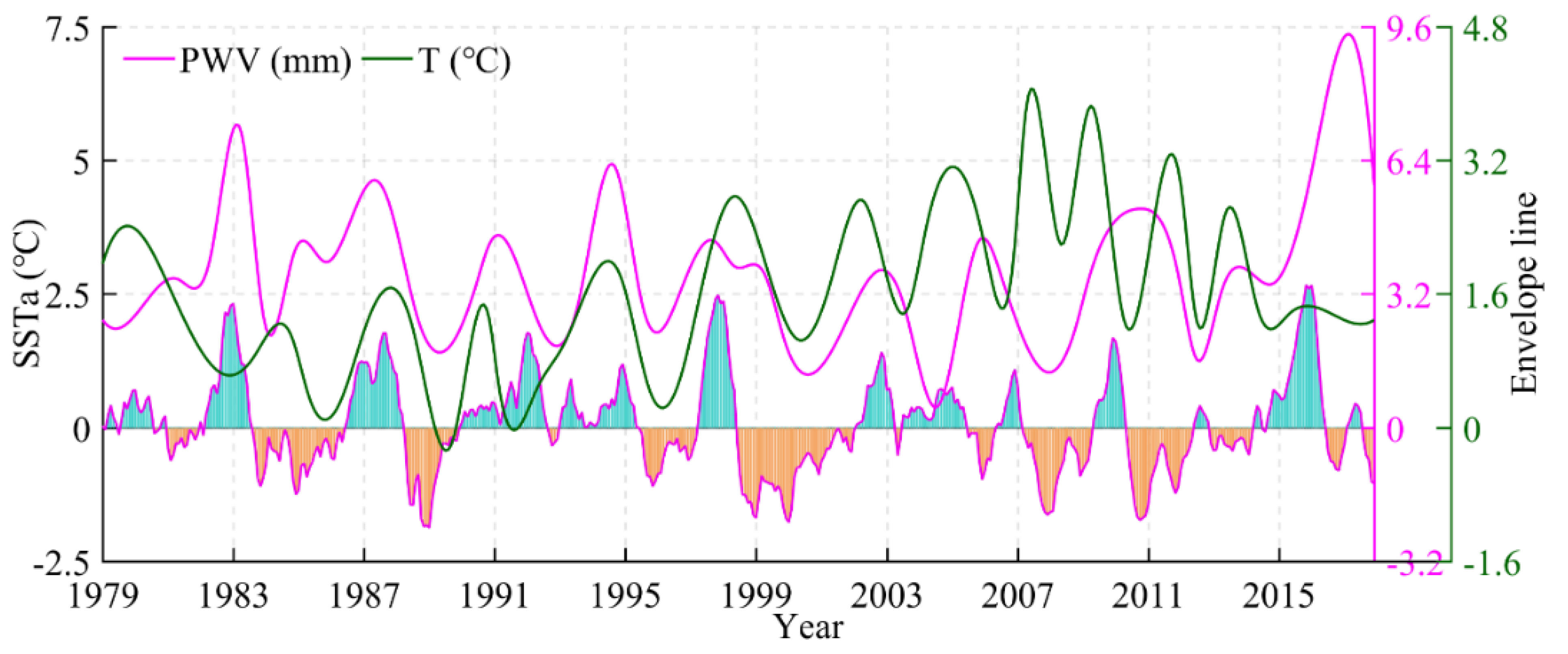
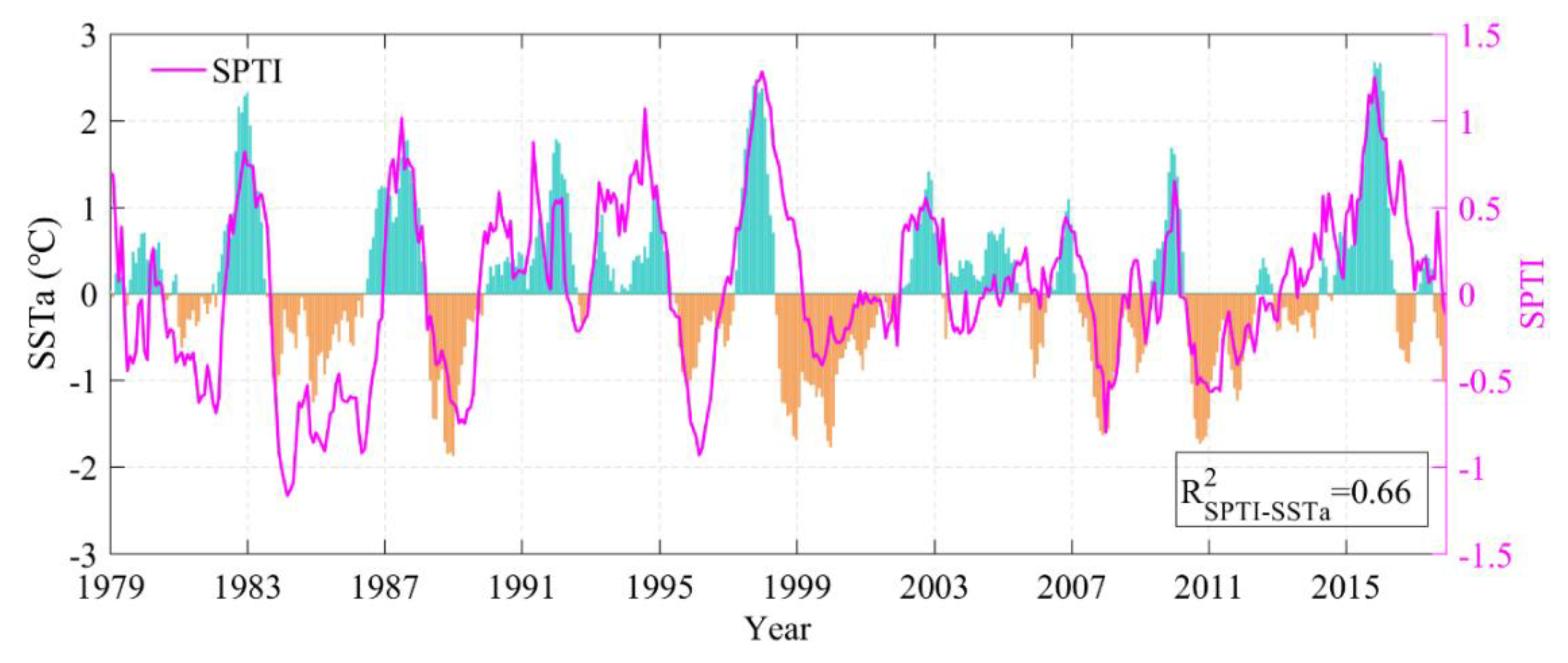
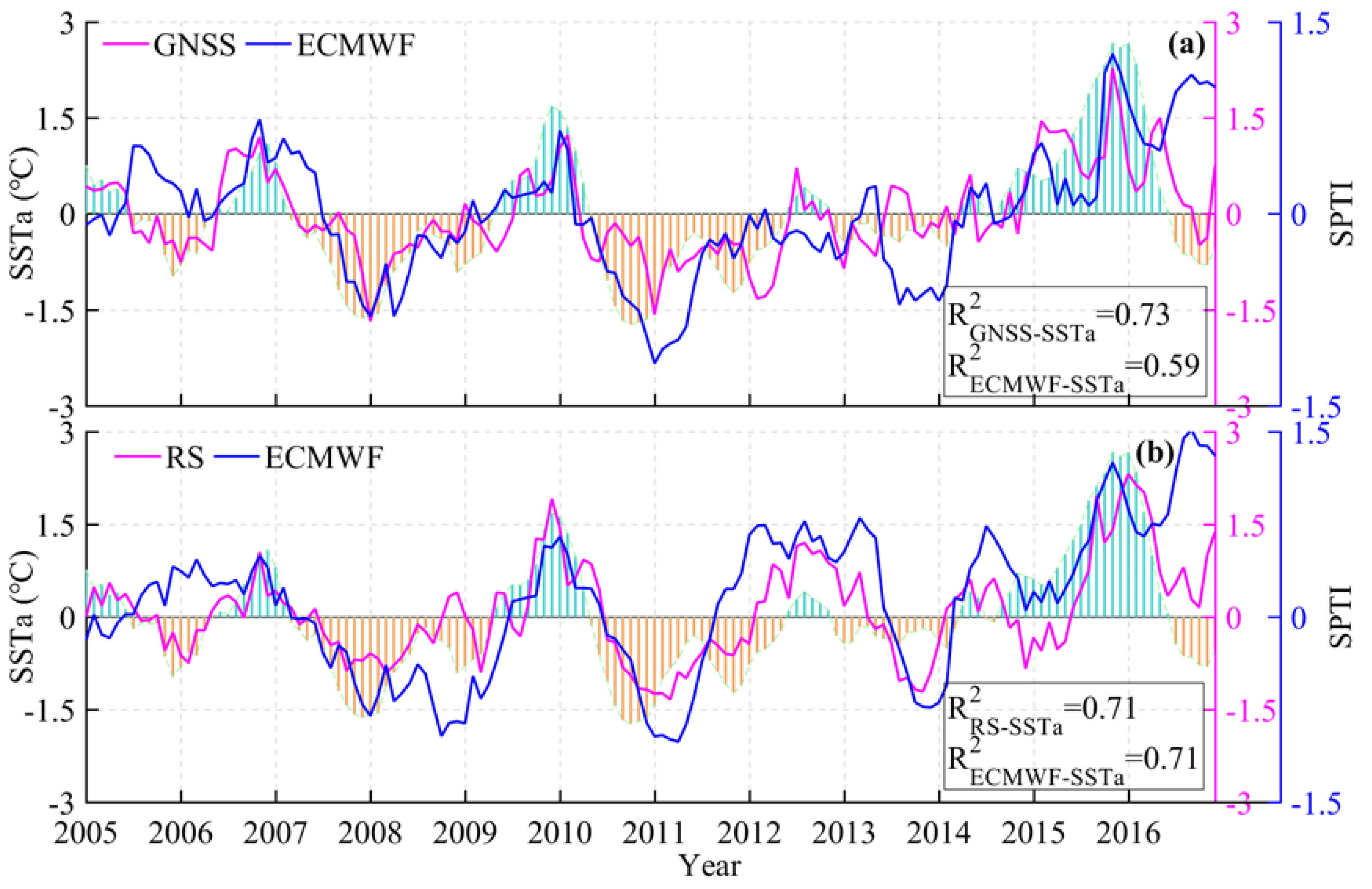
| Data | Spatial and Temporal Resolution | Temporal Coverage/Year | Sources | |
|---|---|---|---|---|
| ECMWF -derived PWV and T | 0.5° × 0.5° | monthly | 1979–2017 | https://www.ecmwf.int/datasets/ |
| SST | 2° × 2° | monthly | 1979–2017 | https://www.esrl.noaa.gov/psd/data/ |
| GNSS-derived PWV | station | hourly | 2005–2016 | [33] |
| RS-derived PWV | station | daily | 2005–2016 | [33] |
| SSTA | El Niño 3.4 | monthly | 1979–2017 | http://www.cpc.ncep.noaa.gov/ |
| Solar radiation | 0.5° × 0.5° | daily | 1981–2016 | https://rda.ucar.edu/datasets/ |
| Contribution Rate | Principal Components | ||||||
|---|---|---|---|---|---|---|---|
| 1 | 2 | 3 | 4 | 5 | 6 | 7 | |
| Variance Contribution Rate | 85.71 | 7.05 | 6.68 | 0.1 | 0.1 | 0.01 | 0.01 |
| Accumulated Variance Contribution Rate | 85.71 | 92.76 | 99.44 | 99.54 | 99.64 | 99.65 | 99.67 |
© 2020 by the authors. Licensee MDPI, Basel, Switzerland. This article is an open access article distributed under the terms and conditions of the Creative Commons Attribution (CC BY) license (http://creativecommons.org/licenses/by/4.0/).
Share and Cite
Zhao, Q.; Liu, Y.; Yao, W.; Ma, X.; Yao, Y. A Novel ENSO Monitoring Method using Precipitable Water Vapor and Temperature in Southeast China. Remote Sens. 2020, 12, 649. https://doi.org/10.3390/rs12040649
Zhao Q, Liu Y, Yao W, Ma X, Yao Y. A Novel ENSO Monitoring Method using Precipitable Water Vapor and Temperature in Southeast China. Remote Sensing. 2020; 12(4):649. https://doi.org/10.3390/rs12040649
Chicago/Turabian StyleZhao, Qingzhi, Yang Liu, Wanqiang Yao, Xiongwei Ma, and Yibin Yao. 2020. "A Novel ENSO Monitoring Method using Precipitable Water Vapor and Temperature in Southeast China" Remote Sensing 12, no. 4: 649. https://doi.org/10.3390/rs12040649
APA StyleZhao, Q., Liu, Y., Yao, W., Ma, X., & Yao, Y. (2020). A Novel ENSO Monitoring Method using Precipitable Water Vapor and Temperature in Southeast China. Remote Sensing, 12(4), 649. https://doi.org/10.3390/rs12040649






